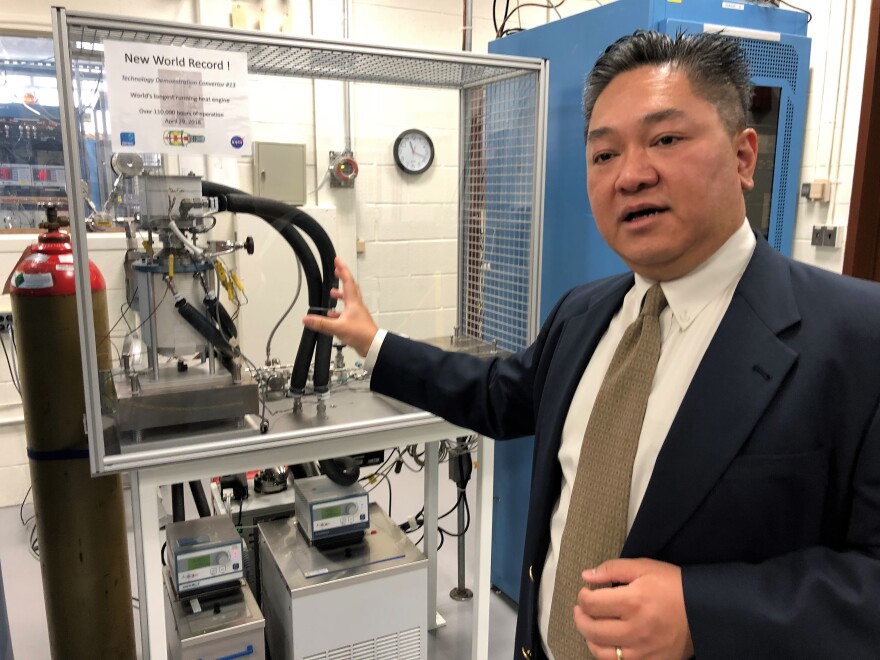While nuclear power in Ohio is heading into the sunset, NASA Glenn in Cleveland has developed a portable nuclear energy system for outer space.
In this Week’s Exploradio, WKSU’s Jeff St.Clair looks at how the system combines a new nuclear concept with a centuries-old mechanical engine.
At the unveiling of the new Kilopower system, Jim Ryder, NASA’s head of space technology laid out why it’s needed.
“When we go to the moon and eventually on to Mars we’re likely to need large power sources not dependent on the sun,” says Ryder.
That’s where portable nuclear power comes in.

Kilopower is a mini-nuclear reactor that designer David Poston calls a milestone.
“This is the first new reactor, not just for space, not just for NASA, of any kind in the U.S. in 40 years,” he says.
Down in the lab at NASA Glenn Research Center, Poston glows over the Kilopower prototype like a proud papa.
“It’s not high-tech,” but, he says, "elegant might be the right word."
Poston says, “This is as simple as you can make a reactor, which is what’s great about it. It’s really letting the physics do the job for you.”
Where NASA and the Simpsons collide
A Kilopower mock-up resembles a round pedestal table, about five ft. tall, almost like something you might find at IKEA. The uranium reactor rests at the bottom of the leg, liquid sodium heat pipes and power convertors reach up to support a circular cooling fan.

It's compact. A one kilowatt Kilopower unit weighs around 900 lbs, a larger 10 kilowatt system would weigh around 3,300 lbs. The cooling fan folds up like an umbrella for ease of shipment.
Kilopower was developed through a series of experiments whose names contrast the normally no-nonsense NASA ethos.
It turns out these guys are huge Simpsons fans, which makes sense since Homer Simpson works in a nuclear plant.
The KRUSTy experiment, or Kilowatt Reactor Using Stirling Technology, is a tongue-in-cheek reference to the show’s chain-smoking Krusty the Clown.
An earlier experiment called the Duff test – a nod Homer’s favorite beer – paved the way for Krusty, according to Los Alamos National Laboratory’s Patrick McClure.
"Duff actually convinced NASA and gave them enough confidence that we could do the more expensive Krusty experiment and we actually had a chance of success,” says McClure.
So how does it work?
Like in Homer Simpson’s plant - the kilopower unit runs on nuclear fission.
That’s a nuclear reaction where a Uranium atom splits in two, creating a chain reaction and plenty of heat.

The coffee can-sized uranium core at the bottom of the Kilopower unit operates at a steady 1,500 degrees Fahrenheit.
And that heat is used to create electricity using a device invented more than 200 years ago that sits on top of the reactor.
It’s called a Stirling engine, named after Scottish engineer Robert Stirling.
A durable solution to space power
NASA engineer Wayne Wong runs the Stirling research lab.
“The Stirling converter is basically a heat engine, it converts heat energy into electrical power," says Wong.
It’s deceptively simple. All you need is a hot side and a cold side. A piston inside the engine cycles between them, happily pumping away for a very long time.
Wong points to a unit inside a glass case that he says has been running continuously for over 110,000 hours, "which as far as we know is a world record." "That's 12 and half years," he adds.
First the moon, then mars
NASA's David Poston says the Kilopower system it’s the first time a Stirling engine has been placed on a nuclear reactor.

The design provides the kind of durability needed when planning a moon station, where it’s dark half time, or a mission to mars, where dust storms can obliterate the sunshine for weeks at a time, making solar power less reliable.
And all this space research comes as operators are decommissioning Ohio’s two nuclear plants.
In fact, no new large scale plants have been built in the U.S. in 30 years, although some smaller units may be developed.
But nuclear power may have a future in space as NASA moves forward with plans to build a moon base in the next decade.










